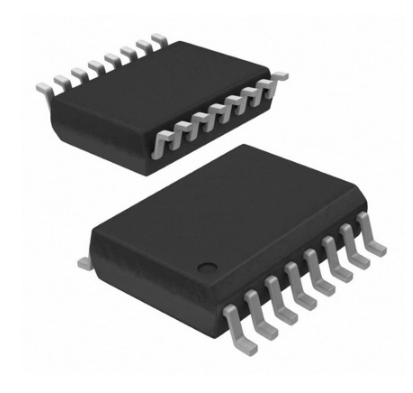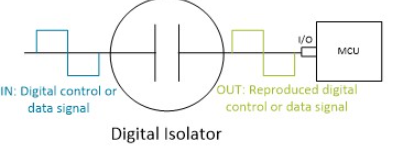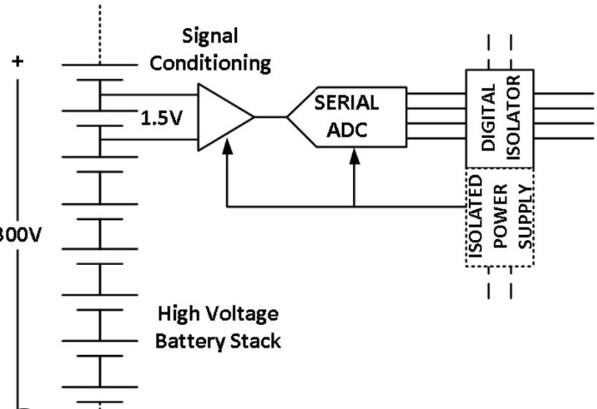Digital Isolator: What is it? How to select right one for your design?

What is a Digital Isolator?
Digital isolator is an electronic device primarily used to provide electrical isolation and transmit digital signals between different circuits. Its main function is to isolate the electrical connection between the input signal and the output signal to prevent potential electrical noise, ground interference, voltage fluctuation and other problems from interfering with or damaging the system. Digital isolators create an electrical isolation barrier between input and output by using optical couplers, magnetic couplers, or other isolation techniques, thereby preventing signal interference, noise propagation, and transmission of faults. This isolation is important to protect and optimize the process of digital signal transmission, and is widely used in industrial automation, communication systems, medical equipment and other fields.

The working principle of the digital isolator is to transmit and convert the digital signal at the input end through the analog or digital interface to ensure that the signal obtained at the output end is exactly the same as the input end. It can convert the digital signal from the input end into optical or magnetic signal, and process it in the isolation layer, and finally output the new signal to the output end, so as to realize the isolated transmission of the signal.
The application of digital isolators is not only limited to industrial control, power energy, communication networks, instrumentation, consumer electronics and other electronic system equipment, but also especially suitable for the need to reduce the ground loop noise, to ensure the safety of data transmission scenarios, through the current isolation to ensure that data transmission is not through the electrical connection or leakage path, so as to avoid safety risks
What is the Difference Between a Digital Isolator and an Optocoupler?
Optocouplers, also known as opto-isolators, use light to transmit signals across an isolation barrier. In contrast, digital isolators use magnetic or capacitive coupling to achieve the same effect. Optocouplers have been around longer, but digital isolators are quickly gaining popularity due to their superior performance in terms of speed, power efficiency, and longevity.
1. Transmission
Optocouplers uses light as a transmission medium to communicate by sending light over physical distances. The logic input generates current on the input side, and the LED output transmits light through a molded composite layer to the receiving photodetector and outputs it. However, digital isolator uses silicon-based semiconductor technology with two integrated circuit chips and a high-voltage dielectric capacitor. At Texas Instruments (TI), the digital signal is converted to the high frequency domain and sent through a capacitance-based SiO2 dielectric isolation layer. This technology uses capacitance or electromagnetic isolation technology to transmit the signal, achieving a long service life, optimizing the BOM material cost of the system, and reducing the PCB are.

2. Performance features
Optocouplers are widely used in the industry because of their early appearance and competitive price. However, the switching speed of leds limits the data rate and requires the use of additional circuit elements, increasing the cost of the application and the PCB area.
Compared with Optocouplers, digital isolators have the advantages of optimized system BOM material cost, reduced PCB area, accurate timing characteristics, lower power consumption.
3. Application
Due to its early advent and cost advantages, Optocouplers are widely used in situations where electrical isolation is required. However, with the advancement of technology, digital isolators are becoming the first choice for many applications due to their higher performance and cost effectiveness, especially in applications with high requirements for transmission rate, power consumption and integration.
What Are the Different Types of Digital Isolators?
Digital isolators come in various types, each utilizing different methods for isolating signals. The selection of a specific type depends on the application requirements, such as speed, noise immunity, power consumption, and the level of isolation needed. Below are the main types of digital isolators:
1. Capacitive Digital Isolators
These isolators use capacitors to transfer signals. They are known for their high speed and low power consumption. Capacitive isolators are suitable for applications that demand fast data rates, such as high-speed communication interfaces.
2. Inductive Digital Isolators
Inductive isolators rely on inductive coils to transmit signals. The changing current in one coil induces a corresponding signal in another coil, achieving isolation. Inductive coupling provides excellent noise immunity, particularly useful in industrial environments where electromagnetic interference (EMI) is prevalent. They are favored in applications where reliability under noisy conditions is critical.
3. Transformer-Based Isolators
These isolators use tiny transformers to transfer energy and signals across an isolation barrier. Transformer-based isolators excel in providing high levels of isolation, often withstanding voltages in the kilovolt range. They are commonly used in applications requiring robust safety measures, such as medical devices or power supply systems, where the need for protection against high-voltage surges is paramount.
4. Optical Coupling Isolators
Although not strictly digital isolators, optocouplers serve a similar function by using light-emitting diodes (LEDs) and photodetectors to transmit signals. The LED transmits light across an isolation barrier, and the photodetector converts the light back into an electrical signal. While optocouplers are slower and less efficient than other types of isolators, they are still used in some legacy systems and applications where optical isolation is preferred.
What is the Working Voltage of a Digital Isolator?
The working voltage of a digital isolator refers to the maximum voltage difference it can handle between the isolated sides without breaking down. This parameter is crucial for ensuring safety and reliability in high-voltage environments.

Working voltages vary depending on the isolator type and application. In general, digital isolators offer working voltages ranging from 500 V to 5,000 V. Higher working voltage ratings are essential for applications that require robust isolation, such as power converters or motor control systems. It’s important to select a digital isolator with a working voltage that matches your system’s needs to prevent failures.
Why Use a Digital Isolator?
Digital isolators create an electrical isolation barrier between input and output by using optical couplers, magnetic couplers, or other isolation techniques. This isolation can prevent signal interference, noise propagation and fault transmission, thereby protecting equipment and personnel from high voltage, high current and other dangerous factors.
1. Safety and Protection
One of the primary reasons to use digital isolators is their ability to protect low-voltage circuits and sensitive components from high-voltage surges. In industrial and power systems, where high voltages and currents are common, digital isolators create a safe barrier between different sections of a circuit, preventing voltage spikes from damaging low-voltage electronics.
2. Signal Integrity in Noisy Environments
In environments with high electromagnetic interference (EMI) or radio frequency interference (RFI), signal integrity can be compromised. Digital isolators are designed to maintain strong signal integrity by isolating the data lines from the noise sources. Capacitive and inductive isolators, in particular, are resistant to EMI.
3. High-Speed Data Transmission
Digital isolators offer much higher data transfer rates compared to traditional optocouplers. Many modern systems require fast communication between isolated sections of a circuit, and digital isolators excel in this area. With data rates often reaching several gigabits per second, they are well-suited for applications like high-speed data buses, telecommunications, and digital signal processing (DSP) systems.
4. Energy Efficiency
Power consumption is a critical factor in the design of electronic systems, especially in portable or battery-powered devices. Digital isolators, particularly capacitive coupling types, consume significantly less power than optocouplers and other traditional isolators.
5. Compact Size and Integration
Digital isolators are typically smaller and more compact than optocouplers, allowing for more efficient use of PCB real estate. Many digital isolators are integrated into IC packages, reducing the need for multiple discrete components. This smaller form factor is particularly beneficial in densely packed designs such as consumer electronics, medical devices, and portable instrumentation, where space constraints are a concern.
6. Compliance with Safety Standards
Digital isolators are designed to meet strict safety standards, such as those from the International Electrotechnical Commission (IEC) and Underwriters Laboratories (UL). These standards ensure that digital isolators provide the necessary protection in high-voltage environments and comply with industry-specific safety regulations. In medical, automotive, and industrial sectors, digital isolators often meet stringent safety and isolation requirements.
What Do I Need to Know When Using a Digital Isolator?
The key information you need to know when using a digital isolator includes:
1. Communication Architecture of Digital Isolator
Digital isolators primarily have two types of communication architectures: edge-based communication and on-off keying (OOK) based communication. In edge-based communication, high-frequency and low-frequency channels are used, where signals are distinguished into small, narrow transients through a specific circuit network and then converted to rail-to-rail differential pulses by a comparator. In OOK-based communication, the concept of signal manipulation and corresponding signaling is used, which is suited to particular application.
2. Safety Limits and Failure Modes
Understanding the safety limits of digital isolators is critical for ensuring safe device operation. Safety limits define the conditions under which a device can operate during a fault. The failure modes and safety limits of an isolator depend on its design and structure. For example, optocouplers transmit signals using LEDs and photodetectors, while digital isolators transmit signals through high-voltage capacitors and electrical transmission and reception circuits. Knowing these factors helps prevent system damage due to failures.
3. Considerations When Selecting a Digital Isolator
The key factors to consider when selecting a digital isolator include component protection, user safety, signal level conversion, and compliance with system safety regulations. Digital isolators add value to systems by implementing additional functions and ensuring safe operation. Moreover, modern digital isolation technology supports large-scale integration, reducing the number of circuit components while improving performance and efficiency.
What is the Failure Mode of a Digital Isolator?
Like any electronic component, digital isolators can fail, although they are highly reliable when used correctly. One of the failure modes of a digital isolator is when a high voltage exceeding the isolator rating occurs, which can cause the isolator to fail. In addition, the design and use of digital isolators also involve some key issues and considerations, such as the difference between basic and enhanced digital isolators, whether different voltages can be applied to both ends of the digital isolator, and whether the signal voltage of the digital isolator can be different from its supply voltage.
To minimize the risk of failure, always ensure that the isolator’s voltage rating matches or exceeds the expected voltages in your system. Proper design and selection of isolators significantly reduce failure risks.
How Do I Choose a Digital Isolator?
When selecting a digital isolator, several key factors must be considered to ensure it meets the specific application requirements and system standards. Here are some major considerations:
1. Understanding Isolation Specifications
l Isolation Voltage (V.ISO): Determine the required isolation voltage level, which is typically dictated by regulatory standards. This represents the voltage the isolator can withstand for at least 60 seconds without breakdown.
l Working Voltage (VIOWM): This is the continuous voltage that the isolation barrier needs to withstand during the product's lifespan.
l Surge Isolation Rating: Determine whether reinforced isolation is necessary. If so, you need an isolator that can handle >10 kV surge pulses.
l Creepage Distance/Clearance: Ensure that the isolator meets system standard requirements for creepage distance and clearance.
l Common Mode Transient Immunity (CMTI): If the system operates in a noisy environment, a high CMTI rating is crucial for digital isolators.
l Power Consumption: Consider if overall system power consumption is a critical specification, such as in 4-20 mA loop-powered or battery-operated systems.
l Data Rate: Choose a data rate that suits the communication interface, whether it's a low-speed UART or a high-speed ≥100 Mbps data protocol.
2. Selecting the Right Packaging
Packaging plays a significant role in isolation performance because the size and characteristics of the packaging directly impact the high-voltage capability of the device. When selecting the right packaging, factors to consider include creepage distance, clearance, working voltage, surge voltage, and isolation rating. Larger packaging with greater creepage distance and clearance will allow for higher isolation voltage specifications.
3. Channel Configuration and Data Rate
Consider the number of isolation channels and their configuration, as well as the transmission rate specifications to ensure they align with the system requirements. Determine how many isolated channels are needed for the signal and the direction of signal transmission for each.
4. Input and Output Power Voltage
Confirm the range of input and output power voltages to ensure the digital isolator operates reliably under the specified voltage conditions.
FAQs
1. Can digital isolators replace optocouplers?
Yes, digital isolators can replace optocouplers in many applications, especially where speed, power efficiency, and longevity are important.
2. Are digital isolators suitable for automotive applications?
Yes, digital isolators are widely used in automotive applications due to their high reliability, fast data rates, and strong EMI resistance.
3. How long do digital isolators last?
Digital isolators are known for their long operational life, significantly outlasting optocouplers, as they don’t suffer from LED degradation.
4. Can digital isolators handle high-voltage surges?
Yes, provided the isolator’s working voltage is correctly matched to your system’s requirements. Digital isolators are designed to withstand high-voltage surges in many applications.
5. What’s the main advantage of using a digital isolator over an optocoupler?
The primary advantages include faster data rates, lower power consumption, and improved longevity, especially in harsh environments.
Statement: All articles (images, texts, audio) on this site are uploaded and shared by users, or integrated from relevant internet sources, only for user's learning. If your rights are violated, please contact the administrator to delete! Link to this article: https://www.jinftry.com
DW-09-14-F-D-940│ DW-15-15-T-S-500│ DW-19-09-F-D-470│ DW-20-14-F-D-1082│ DW-38-20-F-D-815│ DWM-18-54-G-S-210│ DWM-27-54-S-S-250│ DWM-32-61-G-D-200│ DWM-38-54-L-D-250│ DWM-40-52-G-S-200-002│ E2A-M18LN16-M3-B2│ E2E-C04N03-WC-B1-5M│ EBC10DCCH-S189│ ECA40DRTI│ ECC12DRAI-S734│ ECC70DCWI│ ECJ26DMCN│ ECM44DSAI│ ED590-7-DS│ EGR03-25│ EHT-122-01-S-D-SM-23-P│ EHT-122-01-S-D-SM-LC-22-K│ EJH-125-01-F-D-SM-46│ EKMG250ELL470ME11D│ EL8302ISZ-T13_152│ ELXS421VSN181MR25S│ EM357-MOD-LR-RF-T│ ERA-3AHD430V│ ERA-8AEB2212V│ ERC5037R900DEEK500│ ERC50536R00FHEA500│ ERC50715R00BEEK500│ ERC5088R700FEEB500│ ERC5513K700BEEK600│ ERC5563K400DKEK500│ ERJ-14NF1803U│ ERJ-H2RF15R0X│ ERJ-H3ED1910V│ ERJ-P6WF1471V│ ERJ-PA2F2053X│ ERJ-PA3J512V│ ERJ-S02F7150X│ ERJ-S06D6650V│ ERJ-S06F6342V│ ERJ-S12D19R6U│ ERJ-U01F1781C│ ERJ-U03D3321V│ ERJ-U03F1201V│ ERJ-U12J1R2U│ ERJ-UP3F62R0V│ ERL0511M000GNEK500│ ERM5-060-04-0-S-DV-TR│ ERM8-050-02-0-L-DV-DSS-K-TR│ ESM28DRTF-S13│ ESQ-117-14-G-D-LL│ ESQ-121-34-S-T-LL│ ESQ-125-39-G-S-LL│ ESQ-135-33-G-S│ ESQT-103-03-G-D-312-006│ ESQT-103-03-M-S-358│ ESQT-108-03-G-D-380│ ESQT-113-02-F-D-781│ ESQT-114-03-G-T-400│ ESQT-146-03-H-6-375│ ESQT-150-02-F-D-705│ ET60S-03-24-02-L-RT1-GP│ EV0961500000G│ EXB-N8V563JX│ F339MX254731KKP2T0│ F461KG823G160L│ FC-135-32-7680KA-AC5│ FCC17B25PB4DB│ FD225R17ME3│ FFA-1S-304-CLAC62│ FLE-111-01-GF-DV-A│ FMF200FRF73-4K7│ FMP100FRF52-80K6│ FOD817D300│ FSI-140-10-L-D-E-K│ FTMH-140-02-L-DV-A-TR│ FTS-110-03-L-DV-S-P│ FTSH-108-01-FM-DV-A│ FTSH-137-05-F-DV│ FTSH-148-01-SM-MT-TR│ FW-05-05-F-D-411-169│ FW-06-02-L-D-350-065│ FW-08-01-L-D-350-075│ FW-09-03-F-D-255-140-P│ FW-10-03-L-D-293-107│ FW-25-02-L-D-410-120│ FW-33-04-L-D-370-150│ G8P-1C4P-DC48│ GA3-12D45Z│ GB8PI│ GBU8M-E3-51│ GEC36DRES-S93│ GMC21X7R222K50NT│ GMC43DRXI-S734│ GRM0335C2A820JA01J│ GRM1555C1H560FA01D│ GRM2166S1H270JZ01D│ GRM31BR72E683KW01L│ GSA15DRMD-S288│ GTCL01F32-22S-027-B30│ GTCR36-750M-R10│ GTS030-20-3S│ GTS07R36-5SX│ GTT38A-TPR-BLH-B0-H1-CT-VPT│ GW-JCLMS1-EC-GTHP-5L7N-L1N2│ H16WD6075│ HBC08DRTI-S93│ HBC20DRYS│ HDWM-20-57-S-D-345-SM-A-P│ HEDL-5500-G12│ HHV-50FT-52-8M87│ HM17-664101LF│ HMC1048LC3BTR-R5│ HMC565-SX│ HPS0631503JKB15│ HSC10DRTI│ HSC18DRYH-S13│ HVR6800004303JAC00│ HZ4B3TD-E│ IEGF66-32427-3-V│ IHLW5050CEER1R5M01│ IHSM3825EB3R3L│ IPB075N04LG│ IRF6810STR1PBF│ IRFS23N20D│ IRG7PH50UPBF│ IS42VM16800G-6BLI│ ISO7831FDW│ JBXFD2J02FCSDSR│ JCK3012D05│ JTP02RE-16-35P-LC│ KF0970500000G│ KJB6T25J61SB│ KJB7T23F21JD│ KNP1WSJT-52-0R75│ KO119A7325│ KTR10EZPJ151│ L06P700S05│ L77TWA11W1SESV4FA203│ LED75W-200-C0350-D│ LFG480303SQDINR│ LKS1J182MESY│ LM2901PWRG4│ LM337BD2TR4G│ LM4040DIM7-2-5-NOPB│ LP2951CN-3-3G│ LP2980IM5X-4-7│ LQW18CN15NJ00D│ LT6238HGN-TRPBF│ LTC2637CDE-HMI12-TRPBF│ LTC3425EUH-TRPBF│ LY2-0-DC6│ M1330-04K│ M39003-01-2250-HSD│ M39003-09-3054│ M52-5051445│ M55342E02B432ARWI│ M55342E04B625ART5│ M55342E06B82A0ST5│ M55342E12B10B0SWP│ M55342K02B453ARWS│ M55342K03B309BRWS│ MAL210657103E3│ MAX17605ASA│ MAX3212EAI-T│ MAX3227EEAE-T│ MAX339ESE-T│ MAX6390XS26D4│ MAX8632ETI-T│ MAX8922ETB-T│ MB90522BPFV-GS-143-BND│ MB96F635RBPMC-GSAE1│ MBA02040C6194FRP00│ MC22FA202J-TF│ MC74ACT139DTR2G│ MC78M05CDTT5│ MCC56-14│ MCT06030C4303FP500│ MDM-21PSK│ ME30A2402C01│ MEA1D0505SC│ MF0207FRD52-698R│ MFR-12FRF52-1R87│ MFR100FRE52-1K78│ MFR1WSDBD52-250R│ MFR2WSFTF52-27K│ MFR50SDBE52-5K62│ MI-222-IW-F4│ MI-27W-MY-S│ MINIHAM1C12│ MM3Z5V1-AQ│ MMBZ5251BS-7│ MMP100FRF13K3│ MMSZ5248BS-7-F│







